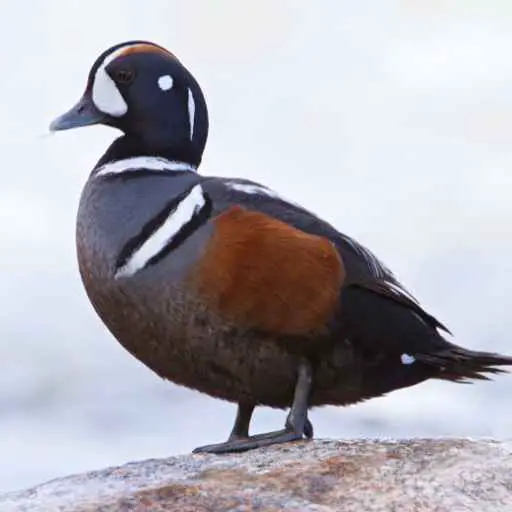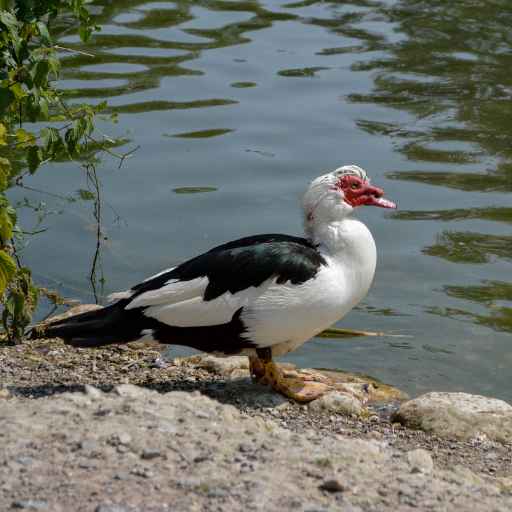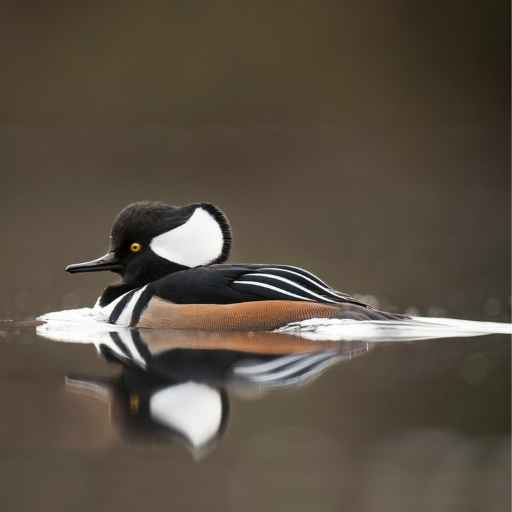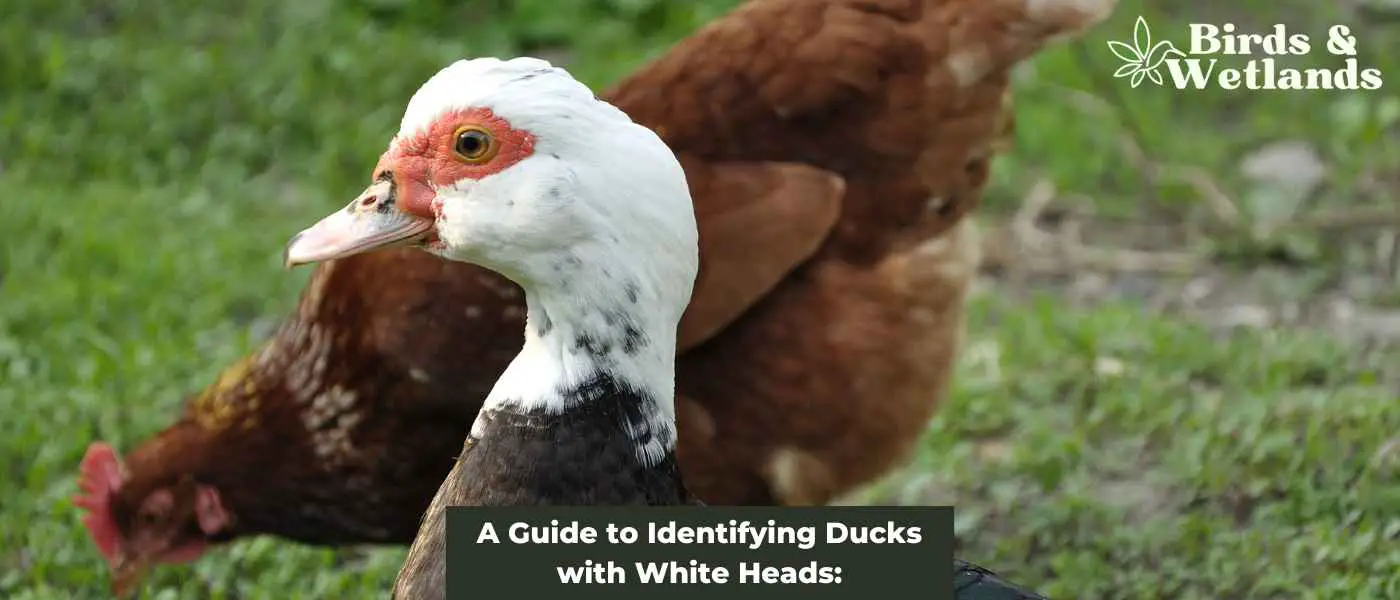Ducks are one of the most recognizable birds in the world, with their distinctive bills and webbed feet. But did you know that there are dozens of ducks, each with unique characteristics?
One feature that sets certain ducks apart is their white heads. These ducks are instantly recognizable but can be difficult to identify beyond this striking trait. Some of these ducks don’t have white heads but rather white spots or patches on their heads.
In this guide, we’ll explore the world of ducks with white heads, including which species to look out for, how to identify them, and some interesting facts about their behavior and habitat.
Whether you’re a birdwatching enthusiast or simply curious about the natural world around you, this guide will help you gain a deeper appreciation for these beautiful and fascinating birds. So grab your binoculars, and let’s get started!
Harlequin Duck
Harlequin Duck

- Scientific Name: Histrionicus histrionicus
- Habitat: Rivers and Small Islands
- Diet: Fish and Mollusks
The Harlequin Duck is a cool bird that lives in North America. The male has bright blue, chestnut, and white stripes, while the female is grayish. They like to live near rough, fast-moving rivers in the spring and summer and rocky coasts in the winter.
Harlequin ducks rest on islands and sandbars in the river, boulders, and rocks near the ocean. These ducks mostly eat bugs and fish. In the winter, they eat things like crabs, mussels, and snails.
Harlequin ducks are tough birds, but they sometimes get hurt from all the rough water they live in.
Mandarin Duck
Mandarin Duck

- Scientific Name: Aix galericulata
- Habitat: Wooded areas
- Diet: Mainly eats plants
Mandarin ducks are strikingly beautiful birds, with the adult male having a red bill, reddish face, and large white crescent above the eye. The male’s breast is purple with two vertical white bars, while the flanks are ruddy, and he has two distinctive orange feathers at the back.
Mandarin ducks are dabblers and land walkers, feeding mostly on plants and seeds, especially beech mast. However, These dabbling ducks also add snails, insects, and fish to their diet, which changes seasonally.
In the fall and winter, mandarin ducks primarily eat acorns and grains, while in the spring, they mainly eat insects, snails, fish, and plants.
During the summer, they feed on dew worms, small fish, frogs, mollusks, and small snakes, often perching in trees or on the ground during the day and feeding mainly near dawn or dusk.
They prefer to nest in cavities in trees close to the water during the spring.
Muscovy Duck
Muscovy Duck

- Scientific Name: Cairina moschata
- Habitat: Woodlands and forests
- Diet: Plants and small animals
Muscovy ducks, scientifically known as Cairina moschata, are a species of waterfowl commonly found in various regions of the world, including Central and South America, as well as parts of North America.
Male Muscovy ducks are typically larger than females. They have a distinct appearance, with a large, red, warty-looking caruncle on their faces that is larger in males than in females. The female plumage is generally less vibrant than males, with a mottled brown and black coloration.
Muscovy ducks inhabit woodlands and forests surrounded by small ponds and rivers. They are particularly adaptable and can thrive in both urban and rural environments. In North America, they are often found near human settlements such as parks, golf courses, and backyard ponds.
Muscovy ducks have a varied diet that includes plants, insects, small fish, and other aquatic creatures. They are known to forage both on land and in the water and are particularly adept at catching insects in mid-air.
Wild Muscovy ducks are also known for their unique behaviors. They are generally social birds and can be found in large groups, particularly during the breeding season.
Domesticated Muscovy ducks are among the most common duck breeds on farms and parks.
Ruddy Duck
Ruddy Duck

- Scientific Name: Oxyura jamaicensis
- Habitat: Swamps and marshes
- Diet: Fish and aquatic invertebrates
The ruddy duck is a type of duck found in North and South America.
During summer, adult male ducks have bright chestnut feathers with black on their heads and white on their cheeks. They also have a large blue bill that is curved inward. Female ruddy ducks are browner with a dark stripes on their cheeks.
Ruddy ducks live near freshwater lakes with plants around them and sometimes in salty marshes. They are good at swimming and diving in water because their feet are at the back of their bodies. They eat plants and seeds, as well as small bugs and other creatures they find in the water.
During the breeding season, ruddy ducks pair up and nest in marshes or on floating plants in the water. The female duck lays eggs and adds grass to the nest as the eggs hatch.
In winter, ruddy ducks move to the southern coasts of North America, Central America, and the Caribbean to find food and stay warm. In Great Britain, they live in unfrozen lakes and ponds.
Hooded Merganser
Hooded Merganser

- Scientific Name: Lophodytes cucullatus
- Habitat: Ponds, rivers and lakes
- Diet: Fish and marine invertebrates
Hooded Mergansers are waterfowl with distinctive physical features. Male hooded mergansers have sharp black-and-white patterns, white chest and chestnut flanks, while females have gray-brown to cinnamon crests.
Hooded Mergansers breed in forested wetlands throughout the eastern half of North America and the Pacific Northwest. They can also be found in treeless wetlands where people have put up nest boxes. Their habitat ranges from the spruce-fir forest in the Northwest to the oak-cypress-tupelo forest in the Southeast.
Hooded Mergansers have a broad diet that includes small fish, aquatic insects, crustaceans, amphibians, vegetation, and mollusks. They dive into clear, shallow forest ponds, rivers, and streams to locate their prey. They swim low in the water, and their legs are far back on their bodies, making them awkward on land.
Adult female ducks often lay eggs in nests of other ducks, including their species. They nest in tree cavities, and their ducklings leave the nest at only one day old.
Bufflehead
Bufflehead

- Scientific Name: Bucephala albeola
- Habitat: Northern forests, small lakes and ponds
- Diet: Aquatic vegetation and invertebrates
The bufflehead has distinctive physical characteristics. The adult male has black feathers on its white body, with a green and purple gloss on its head. On the other hand, the female has dark brown feathers and a white cheek patch. Both males and females have pink webbed feet and bluish-grey legs. These ducks have large heads.
Buffleheads breed in boreal forests in the northern parts of North America, from Alaska to the Great Lakes and as far south as northern Mexico. They are also found in western Canada.
These diving ducks breed around ponds and small lakes in mixed coniferous and deciduous forests during the late spring and early summer months. During the winter, they prefer protected coastal waters like coastal bays and estuaries.
In the fall, they migrate to their winter habitats, and during the breeding season, they nest in cavities like tree holes or nest boxes. The nest is lined with down and may be reused by female buffleheads.
The bufflehead feeds primarily on invertebrates, insects, and fish eggs and sometimes eats small fish and seeds from plants. They dive underwater to catch their prey and can swallow it while submerged.
The bufflehead population is stable but steadily declining due to lead poisoning and habitat loss. They are monogamous and mate with the same partner for years.
Common Eider
Common Eider

- Scientific Name: Somateria mollissima
- Habitat: Freshwater lakes and ponds
- Diet: Aquatic vegetation, fish and invertebrates
The common eider (Somateria mollissima) is a sea duck species that exhibit sexual dimorphism in its physical appearance. Breeding males have a striking appearance with a black crown, a white central stripe on the head top, and black extending down to the eyes, lores, and sides of the greenish shield. They also have black flight feathers and rump, making them easily distinguishable from females.
On the other hand, females have a less conspicuous appearance, with grayish-brown to reddish-brown overalls and a black barred body.
Common eiders are found in northern Europe, Eastern Russia, and North America. This duck is primarily a coastal species, inhabiting marine and freshwater habitats, such as tundra, pools, and streams. In winter, its wintering grounds include shallow bays, seacoasts, and river mouths. They are often seen with other large ducks such as the long-tailed ducks which have dark crowns or black caps and white necks.
The common eider feeds primarily on aquatic plants, fish, mollusks, crustaceans, insect larvae and other marine invertebrates. They are skilled divers who use head-dipping and upending techniques to search for food.
Common eiders breed in Arctic regions on small offshore islands or isolated nesting sites with dense vegetation, free of terrestrial predators such as mammals. Adult females build their nests from various materials, including down feathers plucked from their own breasts, and line them with soft materials such as seaweed. They nest in loose colonies and large flocks, with hundreds or thousands of individuals nesting nearby.
Smew
Smew

- Scientific Name: Mergellus albellus
- Habitat: Lakes and rivers
- Diet: Fish
Smews are a type of duck that live in freshwater habitats like shallow waters, lakes and rivers during the breeding season and saltwater coasts, estuaries, and bays during winter.
Males have a distinctive black and white plumage with a red eye, while females lack the white coloration and have a brownish-gray body with a white patch on their cheek.
They primarily eat fish and other small aquatic creatures, and they are good at diving to great depths to catch them. Smews breed in northern Europe and central Asia and build their nests on the ground near water. The female lays 6 to 9 eggs, and the young ducks are able to feed themselves shortly after hatching.
Key Takeaways on White-Headed Duck
- Harlequin ducks prefer rivers and small islands and mainly eat fish and mollusks.
- The Mandarin duck mostly eats plants and seeds with occasional bugs and fish.
- Muscovy ducks are found all over the world, and thrive in urban and rural environments.
- Female and male buffleheads have gray bills.

